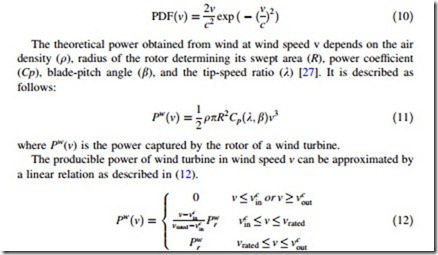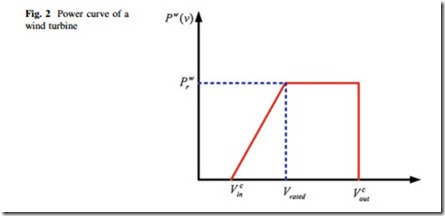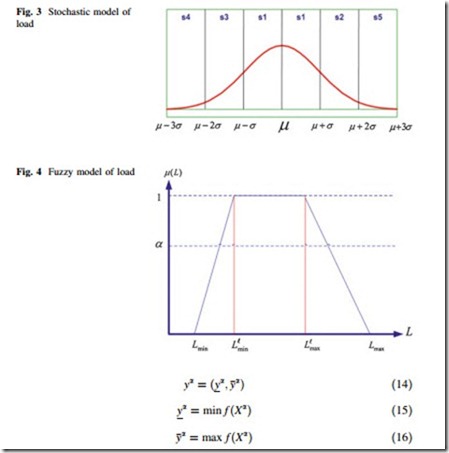Uncertainty Modeling of Wind Turbine Power Generation and Load
In this section the common ways of modeling wind power and load uncertainty are discussed.
Wind Turbine Power Generation Modeling
Suppose that the probability density function (PDF) of wind speed (v) is known in the region under study and it is described as follows [4]:
The approximate linear power curve of a wind turbine is depicted in Fig. 2. This method of wind power generation uncertainty modeling is used for various applications like DG impact assessment [4] and optimal multi-area generation schedule considering renewable resources [28].
The formulation of power curve provided in (12) is the theoretical power curve. In practice, the actual power curve (which relates the wind speed with the wind turbine power generations) deviates from its theoretical value due to the following reasons [29]:
• Wind speed measurement errors.
• Variations in air density which affects the output power.
• Yaw and pitch misalignments.
• Shading effects and wind obstacles caused by neighboring turbines.
Probabilistic Modeling of Load
In this case, it is assumed that the historic data of load is in hand and it can be modeled using probabilistic approach. The normal distribution is an appropriate choice for modeling the load as shown in Fig. 3. The only necessary data for this uncertainty modeling is the mean and variance of historic data. This method of load uncertainty modeling is used for DG planning [30, 31], optimization of power system operation [32].
Possibilistic Modeling of Load
The possibilistic modeling of uncertainty or fuzzy arithmetic refers to a model developed by Zadeh in 1965 [33]. In this approach, a membership function is assigned to each uncertain parameter X~ which describes the behavior and the known data about it. The membership function defines the degree that the component x belongs to fuzzy setX~. Recall the function ~y ¼ f ðX~Þ; if the membership function of X, l(x) is known then what is the membership function of y, l(y)? One of the common fuzzy membership functions is fuzzy trapezoidal number (FTN)
In other words, for each a-cut, the upper/lower bounds of ya are calculated. After determination of membership function for y, it is sometimes necessary to convert it into a real number. This procedure is called deffuzzification [35]. Dif- ferent deffuzzification techniques exist such as centroid method [36], weighted average deffuzzification technique, etc. The deffuzzified value of a given fuzzy quantity, i.e. Y~, is calculated as follows:


